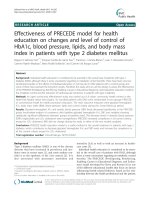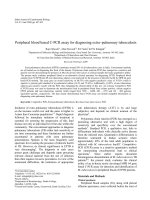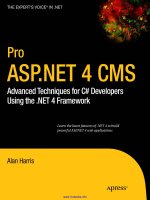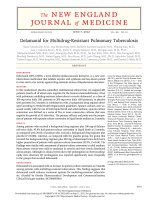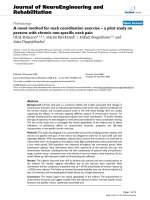Novel method for sputum induction using the Lung Flute in patients with suspected pulmonary tuberculosis pdf
Bạn đang xem bản rút gọn của tài liệu. Xem và tải ngay bản đầy đủ của tài liệu tại đây (143.28 KB, 4 trang )
SHORT COMMUNICATION
Novel method for sputum induction using the Lung Flute in
patients with suspected pulmonary tuberculosis
resp_1584 899 902
AKIRA FUJITA, KENGO MURATA AND MIKIO TAKAMORI
Department of Pulmonary Medicine, Tokyo Metropolitan Fuchu Hospital, Tokyo, Japan
ABSTRACT
Background and objective: The Lung Flute is a small
self-powered audio device that generates sound waves,
which vibrate in tracheobronchial secretions. This was
a preliminary trial to evaluate the usefulness of the
Lung Flute for sputum sampling in patients suspected
of pulmonary tuberculosis (TB).
Methods: Thirty-four patients who were not expecto-
rating sputum, but for whom sputum examination was
required for the differential diagnosis of TB or other
diseases, were enrolled in the study. Patients were
instructed to blow out fast and hard through the Lung
Flute and to repeat this for a total 20 sets of two blows
each.
Results: Using the Lung Flute, sputum samples were
collected within 10 or 20 min from 30 of 34 patients
(88%). The device permitted a rapid diagnosis of TB in
seven of 15 confirmed TB cases. In three patients acid-
fast bacillus smears were positive. In four patients
acid-fast bacillus smears were negative, but PCR tests
for TB were positive. Hyperventilation-related symp-
toms occurred in three patients.
Conclusions: The application of the Lung Flute may
represent a promising technique for the rapid diagno-
sis of pulmonary TB.
Key words: audio device, diagnosis, polymerase chain
reaction, sputum induction, tuberculosis.
INTRODUCTION
Tuberculosis (TB) is a major health problem in the
Western Pacific region, which accounts for about one-
third of the global TB burden. In addition, TB is the
leading cause of death worldwide, among individuals
infected with HIV.
Sputum examination is a key diagnostic procedure
for patients suspected of having pulmonary TB,
including those for whom bronchoscopy is planned.
1,2
In addition, early identification of persons with TB
remains the most effective way of preventing TB
transmission. However, some patients are unable to
produce sputum for examination. In such cases,
sputum induction by aerosol inhalation and/or
gastric aspiration has been preferred.
3,4
The Lung Flute (Medical Acoustics, Buffalo, NY,
USA) is a small self-powered audio device that gener-
ates sound with a frequency of 18–22 Hz with an
output of 110–115 dB using a pressure of 2.5 cm H
2
O.
This sound wave, when generated at the mouth by
mild exhalation, travels back down the tracheobron-
chial tree and vibrates in tracheobronchial secretions.
The device consists of a mouth piece and a reed inside
a 36.8-cm rectangular hardened plastic tube (Fig. 1).
The Lung Flute supplements the natural mucus clear-
ing system by artificially vibrating the airways and
cilia at frequencies between 16 and 25 Hz.
5
The Lung Flute was approved by the US Food and
Drug Administration for sputum induction for diag-
nostic purposes in 2006, and it was registered for sale
in the European Union as a Class 1 medical device in
2007. Recently, analysis of samples obtained using
the Lung Flute revealed no statistically significant
differences in biological markers or cell counts as
compared with sputum samples induced using
hypertonic saline in patients with chronic bronchitis
(Sanjay Sethi, unpubl. data, 2006). There have been no
published clinical studies examining its use in the
diagnosis of TB. In a preliminary trial, we have evalu-
ated the usefulness of the Lung Flute for sputum sam-
pling in patients with suspected pulmonary TB.
Correspondence: Akira Fujita, 2-9-2 Musashidai, Fuchu-shi,
Tokyo 183-8524, Japan. Email:
Conflict of interest statement: The authors did not receive
research funding from Medical Acoustics, LCC and Medical
Acoustics; LCC did not influence the outcome of studies or the
results reported in this paper.
Received 25 May 2008; invited to revise 9 June 2008, 10
November 2008, 25 November 2008, 29 December 2008; revised
22 August 2008, 23 November 2008, 30 November 2008, 31
December 2008; accepted 9 February 2009 (Associate Editor:
Andreas Diacon).
SUMMARY AT A GLANCE
The usefulness of a small audio device for sputum
sampling was evaluated in patients with suspected
pulmonary tuberculosis. This preliminary report
indicates that the device may be clinically useful
for the rapid diagnosis of pulmonary tuberculosis.
© 2009 The Authors
Journal compilation © 2009 Asian Pacific Society of Respirology
Respirology (2009) 14, 899–902
doi: 10.1111/j.1440-1843.2009.01584.x
METHODS
Thirty-four patients, who were not expectorating
sputum spontaneously, but for whom sputum exami-
nation was required in order to make the differential
diagnosis between TB and other diseases such as non-
tuberculous mycobacterial (NTM) lung disease, were
enrolled between December 2006 and August 2007.
Patients were aged 18 years and over, and their CXR
showed lesions such as scattered infiltrates and cavi-
ties, suggesting pulmonary TB. After initial screening
based on symptoms and CXR at primary care clinics,
patients suspected of having pulmonary TB were
referred to the TB clinic at Tokyo Metropolitan Fuchu
Hospital. Patients with hypoxaemia (SaO
2
< 90% by
pulse oximetry) and those with bronchial asthma
were excluded.
Experimental use of the Lung Flute was approved
by the ethics committee at Tokyo Metropolitan Fuchu
Hospital, as the device has yet to be cleared for use in
patients by the Japanese authority. Individual Lung
Flutes were supplied for each patient by Medical
Acoustics, Tokyo, Japan. Written informed consent
was obtained from all patients.
Of the 34 patients, 10 were male and 24 female, their
mean age was 51 Ϯ 19 (SD) years, and the numbers of
never, former and active smokers were 23, 7 and 4,
respectively. Radiologically, the disease was unilateral
in 19 patients, and cavities were present in four
patients.
On or close to the day of their first visit to the clinic,
patients were instructed to blow out fast and hard
through the Lung Flute and to repeat the manoeuvre
for a total of 20 sets of two blows each. Printed
instructions were handed to the patients, and they
were directly supervised in the use of the device by
physicians and nurses as follows:
6
1 Sit with back straight. Tilt head slightly downward
so throat and windpipe are wide open.
2 Inhale a little deeper than normal. Place lips com-
pletely around mouthpiece.
3 Blow out through the Lung Flute like blowing out a
candle. It makes a fluttering sound.
4 Remove the mouthpiece from mouth and take a
quick breath.
5 Replace the mouthpiece and blow out again. Wait
5 s while taking a couple of breaths.
6 Repeat for a total of 20 sets of two blows each.
7 Do not use diaphragm or abdominal muscles to try
to force out more air.
8 Prepare a glass of water to drink after examination.
9 Cough up sputum into a sterile container.
For all patients, use of the Lung Flute and sputum
induction were performed in a negative ventilation
room, as a precautionary infection control measure.
Patients remained in the room for up to 30 min, until
they produced sputum. The microbiology laboratory
complied with the guidelines for TB examination of
the Japanese Society of Tuberculosis.
7
Sputum specimens collected from patients were
homogenized with a mucolytic agent (N-acetyl-L-
cysteine) and decontaminant (1–2% sodium hydrox-
ide solution) to render bacteria nonviable. Smears
were prepared directly from the clinical specimens
and were reconfirmed using concentrated prepara-
tions. Acid-fast bacillus (AFB) in stained smears
was examined microscopically by the fluorochrome
procedure. PCR nucleic acid amplification was
performed on specimens using the AMPLICOR MTB
assay (Roche, Basel, Switzerland), regardless of the
AFB smear results. All specimens were cultured for
mycobacteria using the mycobacterial growth indica-
tor tube (MGIT) system (Becton Dickinson, Franklin
Lakes, NJ, USA). The presence of Mycobacterium
tuberculosis was confirmed by immunochromato-
graphy using anti-MPB64 monoclonal antibodies
(Capilia TB assay; Becton Dickinson, Tokyo, Japan).
Other species of mycobacteria were identified by the
nucleic acid amplification test for Mycobacterium
avium complex or the DNA-DNA hybridization
technique (Kyokuto Pharmaceutical Industrial Co.
Ltd., Tokyo, Japan).
The exact volume of sputum induced was recorded
for 17 of 34 patients. Thirty patients completed a
voluntary self-complete questionnaire after using the
Lung Flute. The following questions were asked: (i) Is
it easy to use the Lung Flute? (ii) Is it easy to under-
stand the instructions on how to use the Lung Flute?
(iii) Did you have a cough after using the Lung Flute?
(iv) Did you produce sputum after using the Lung
Flute? (v) Did you have increased phlegm after using
the Lung Flute? and (vi) Any comments?
RESULTS
Using the Lung Flute, sputum samples were collected
from 30 of 34 patients (88%), who did not produce
sputum spontaneously. The procedure was successful
in nine of 10 male patients (90%) and 21 of 24 female
patients (88%). With regard to smoking status, it was
successful in 11 current smokers and ex-smokers
(100%) compared with 19 of 23 non-smokers (83%).
Patients expectorated sputum within 10 or 20 min
after using the device. The volume of sputum induced
after using the Lung Flute ranged from 1 to 5 mL,
although data were recorded for only 17 patients.
Nine patients expectorated 1 mL or less of sputum
(Table 1).
The final diagnosis was confirmed as pulmonary TB
in 15 patients (bacter iological diagnosis regardless of
specimens in 12, clinical diagnosis in 3), NTM lung
Figure 1 The Lung Flute consists of a mouth piece and a
reed inside a 36.8-cm plastic tube.
A Fujita et al.900
© 2009 The Authors
Journal compilation © 2009 Asian Pacific Society of Respirology
Respirology (2009) 14, 899–902
disease in 9 (M. avium 3, Mycobacterium gordonae 1,
Mycobacterium xenopi 1, Mycobacterium fortiutum 1,
possible NTM 3) and other diseases in 10. A case that
did not satisfy the American Thoracic Society (ATS)/
Infectious Diseases Society of America (IDSA) micro-
biological criteria for NTM lung disease but met the
clinical criteria was defined as a ‘possible NTM case’.
8
For three patients the AFB smear was positive and
TB-PCR was also positive, while for four patients the
AFB smear was negative but TB-PCR was positive
(Table 2). ‘Rapid TB diagnosis’ was defined as AFB
smear-positive and/or TB-PCR-positive in sputum on
the day or a few days after the first visit, without
awaiting the culture results. By this definition the
Lung Flute yielded rapid TB diagnoses in seven of 15
TB patients (47%). In these patients, TB treatment was
started immediately, without further examinations
such as gastric juice sampling or fibreoptic bron-
choscopy (FB). Within 6 weeks, the diagnosis was
confirmed bacteriologically by positive culture results
and a positive Capilia TB assay.
Of the five patients for whom a rapid diagnosis
was not made (AFB smear-negative and TB-PCR-
negative), one was AFB culture-positive and Capilia
TB-positive in induced sputum, one was AFB culture-
positive on follow-up sputum examination, and two
were diagnosed from FB specimens. The remaining
patient was diagnosed clinically after improvement
with TB treatment, although the FB specimens were
negative.
There were three patients who did not produce
sputum but who were diagnosed with TB. One was
AFB smear-positive on the day after sputum in-
duction, one was QuantiFERON-TB 2G-positive but
FB-negative, and one showed a clinical response to
treatment.
Eight of the nine patients with NTM lung disease
expectorated sputum with the Lung Flute. Only one
patient was AFB smear-positive and M. avium PCR-
positive, three were AFB culture-positive, and four
were culture-negative in sputum induced with the
Lung Flute.
The Lung Flute was user-friendly for 22 (73%)
patients as assessed by the voluntary questionnaire
completed by 30 of 34 patients. Eighteen (60%)
patients answered that it was easy to understand the
instructions. Cough after use of the Lung Flute was
reported by 10 patients (33%), expectoration immedi-
ately after use by 8 (27%), and increased sputum by 4
(13%).
Adverse events associated with use of the Lung
Flute included mild sore throat after blowing into the
device in four patients (12%) and hyperventilation-
related symptoms in three patients (9%), including
dizziness in two (6%), headache in one (3%) and dis-
comfort when breathing in one (3%). These symp-
toms did not necessitate medical treatment and
improved rapidly.
DISCUSSION
Use of the Lung Flute enabled rapid diagnosis of TB
in 47% of confirmed TB patients, who had produced
no sputum prior to using the device. The device
was user-friendly as assessed by a questionnaire
completed by the patients.
No major adverse effects were observed when using
the Lung Flute. Some patients complained of dizzi-
ness and discomfort, and were advised to take three
or more slow breaths between the two sets of blows.
Complaints of a sore throat may have been due to
mucus collecting in the throat, and this could be
reduced by drinking water after sputum induction.
Acid-fast bacillus smears were positive in some
patients who produced 1 mL or less of sputum after
using the Lung Flute. Warren et al. indicated that use
of more than 5 mL of spontaneous sputum increased
the sensitivity of AFB smears for M. tuberculosis.
9
However, the relationship between volume of in-
duced sputum and sensitivity for diagnosis of TB has
not been well studied. Brown et al. suggested that
there was no association between sputum volume
and positive culture results.
10
To our knowledge, this is the first report of the
clinical use of the Lung Flute in diagnosis of TB. The
device may represent a new technology for sputum
induction for the diagnosis of pulmonary TB. The
Lung Flute for sputum induction was invented
recently by Hawkins in the USA. Tracheal ciliary
beating motion creates vibrations at 25 Hz that help
to clear mucus.
11
The Lung Flute artificially produces
sound that resonates with the natural frequency and
consequently makes mucus secretions thinner and
Table 1 Number of patients by volume of sputum
obtained with the Lung Flute
Volume of
sputum (mL)
Number of
patients (%)
<1 4 (24)
1 5 (29)
2 3 (18)
4 4 (24)
>5 1 (6)
Sputum volume was only recorded for 17 patients.
Table 2 Diagnostic yield when the Lung Flute was used
in patients with tuberculosis (n = 15)
Yield
Number of
patients (%)
Rapid TB diagnostic yield 7 (47)
AFB smear-positive/PCR-positive
†
3 (20)
AFB smear-negative/PCR-positive
†
4 (27)
AFB smear-negative/PCR-negative 5 (33)
Culture-positive 1 (7)
Culture-negative
‡
4 (27)
Did not expectorate
‡
3 (20)
†
Culture-positive and Capilia TB assay-positive.
‡
See text for explanation of further examinations for
the diagnosis of TB.
AFB, acid-fast bacillus; TB, tuberculosis.
Novel method for sputum induction in TB 901
© 2009 The Authors
Journal compilation © 2009 Asian Pacific Society of Respirology
Respirology (2009) 14, 899–902
more easily expelled by coughing.
5
Although the
Lung Flute depends on patient effort, it is non-
invasive and easy to use. The device does not require
special equipment or an electric power supply, and
the patient need not have an empty stomach before
using it. Patients can easily carry the device and use
it at home repetitively.
Generally, an induced sputum sample can be
obtained by having the patient inhale a hypertonic
saline mist for a patient who cannot cough up sputum
on his or her own. In addition, repeated sputum
induction could considerably improve diagnostic
sensitivity for the diagnosis of pulmonary TB.
12
Micro-
scopic examination of three consecutive sputum
specimens is recommended in patients suspected of
having pulmonary TB.
13
But, most patients feel dis-
comfort of throat during the inhalation of irritant
hypertonic saline. In clinical practice, single induced
sputum specimen has been obtained for patients who
are unable to produce sputum. If effective and conve-
nient sputum sampling can be performed at the first
visit to a medical provider, a physician may make a
rapid diagnosis of pulmonary TB and the early triage
of patients who have infectious TB. In such sense,
using the Lung Flute may a potential method for
sputum induction.
There are some limitations to the present study.
This was a preliminary investigation performed only
in the setting of a TB clinic, and the number of
patients was small. In addition, the effects of various
factors, such as age, smoking status, symptoms and
radiological TB stage on the utility of the Lung Flute,
were not assessed. The fundamental effectiveness of
the device needs to be verified by comparing the Lung
Flute with a dummy device that does not contain a
reed. Finally, a randomized controlled study is needed
to compare the Lung Flute with the current recom-
mended method of sputum induction by hypertonic
saline inhalation for the diagnosis of TB.
In summary, use of the Lung Flute may be a prom-
ising technique for the rapid diagnosis of pulmonary
TB. The diagnostic yield using the Lung Flute needs to
be confirmed in controlled studies.
REFERENCES
1 American Thoracic Society and the Centers for Disease Control.
Diagnostic standards and classification of tuberculosis in adults
and children. Am. J. Respir. Crit. Care Med. 2000; 161: 1376–95.
2 The Advisory Council for the Elimination of Tuberculosis, the
National Commission on Correctional Health Care, and the
American Correctional Association. Prevention and control of
tuberculosis in correctional and detention facilities: recommen-
dations from CDC. MMWR Recomm. Rep. 2006; 55 (No. RR–09):
1–44.
3 Schoch OD, Rieder P, Tueller C, Altpeter E, Zellweger JP et al.
Diagnostic yield of sputum, induced sputum, and bronchoscopy
after radiologic tuberculosis screening. Am. J. Respir. Crit. Care
Med. 2007; 175: 80–6.
4 Conde MB, Soares SLM, Mello FCQ, Rezende VM, Almeida LL.
Comparison of sputum induction with fiberoptic bronchoscopy
in the diagnosis of tuberculosis: experience at an acquired
immune deficiency syndrome reference center in Rio de Janeiro,
Brazil. Am. J. Respir. Crit. Care Med. 2000; 162: 2238–40.
5 Medical Acoustics. Product overview. Lung Flute® operation.
[Accessed 29 November 2008]. Available from URL: http://
www.medicalacoustics.com/Home/LungFlute/Overview/
LungFluteOperation.
6 Medical Acoustics. View Lung Flute® Video. [Accessed 29
November 2008]. Instructional video available from URL: http://
www.medicalacoustics.com/files/video/lung_flute_usage.wmv.
7 The Japanese Society for Tuberculosis. The Guidance for Tuber-
culosis Examination 2007. Japan Anti-Tuberculosis Association,
Tokyo, 2007 (in Japanese).
8 Griffith DE, Aksamit T, Brown-Elliott BA, Catanzaro A, Daley C
et al. An official ATS/IDSA statement: Diagnosis, treatment, and
prevention of nontuberculous mycobacterial diseases. Am. J.
Respir. Crit. Care Med. 2007; 175: 367–416.
9 Warren JR, Bhattacharya M, De Almedia KNF, Trakas K, Peterson
LR. A minimum 5.0 ml of sputum improves the sensitivity of
acid-fast smear for Mycobacterium tuberculosis. Am. J. Respir.
Crit. Care Med. 2000; 161: 1559–62.
10 Brown M, Varia H, Bassett P, Davidson RN, Wall R et al. Prospec-
tive study of sputum induction, gastric washing, and bronchoal-
veolar lavage for the diagnosis of pulmonary tuberculosis in
patients who are unable to expectorate. Clin. Infect. Dis. 2007; 44:
1415–20.
11 Fraser RS, Müller NL, Colman N, Paré PD. Pulmonar y defense
and other nonrespiratory functions. In: Fraser RS, Pare PD (eds)
Diagonosis of Disease of the Chest. W.B. Saunders, Philadelphia,
PA, 1999; 126–35.
12 Al Zahrani K, Al Jahdali H, Poirier L, René P, Menzies D. Yield of
smear, culture and amplification tests from repeated sputum
induction for the diagnosis of pulmonary tuberculosis. Int. J.
Tuberc. Lung Dis. 2001; 5: 855–60.
13 Jensen PA, Lambert LA, Iademarco MF, Ridzon R; CDC. Guide-
lines for preventing the transmission of Mycobacterium tubercu-
losis in health-care settings, 2005. MMWR Recomm. Rep. 2005; 54
(RR-17): 1–141.
A Fujita et al.902
© 2009 The Authors
Journal compilation © 2009 Asian Pacific Society of Respirology
Respirology (2009) 14, 899–902


